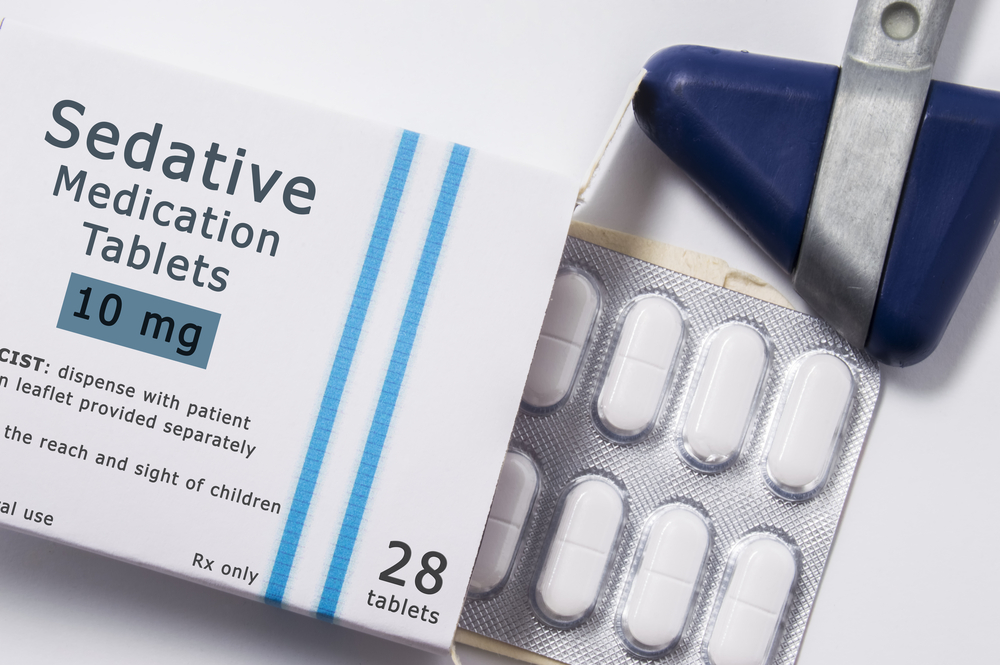Tranquilizers are a group of pharmacological preparations, the main task of which is to eliminate anxiety and psycho-emotional voltage. In addition to these effects, this drug group may have a sleeping pills, anticonvulsant action, as well as muscularlylabing and stabilizing. The main diseases under which tranquilizers are applied are both neurosis-like states. However, this is not all indications for use. To date, there is a huge number of tranquilizers. Each drug has its own characteristics, allowing the doctor to individually approach the medical process. This article will help you form an idea of \u200b\u200bwhat is tranquilizers, how they work, which are. You will be able to familiarize yourself with the most common representatives of this group of medicines, the spectrum of their use, the features of use.
So, tranquilizers. The name comes from the Latin word "Tranquillo", which means soothe. The synonyms of this term are words such as "anxiolyti" (from Latin Anxius - alarming and "Lysis" - dissolution) and "Ataraktics" (from the Greek "Ataraxia" - calmness, calm). However, the most common is the term "tranquilizers". Based on the name, it becomes clear that this group of medicines is aimed at eliminating anxiety and fears, the elimination of irritability and emotional tension. Tranquilizers soothing the human nervous system.
Tranquilizers are known to medicine since 1951, when the first preparation of this class Meproamat was created. Since then, this group of medicines is pretty replenished and continues to do it. The search for new tranquilizers is due to the need to minimize side effects from their application, eliminate the effect of addictive to some of them, achieve a rapid offensive effect. It does not mean at all that there are no worthy of existing drugs. Just the whole world seeks to excellence, and medicine including.
What are the tranquilizers?
A group of tranquilizers is heterogeneous in its chemical composition. In this principle, their classification is based. In general, all tranquilizers are divided into two large groups:
- benzodiazepine derivatives;
- preparations of other pharmacological groups with anti-exploit effect.
The most common among benzodiazepine derivatives are diazepam (sybazone, relaignation, valium), phenazepam, guides, alprazolam, tofizopams (Grandaxine). Among the tranquilizers from other chemical groups of frequently encountered are hydroxyzine (atarax), Mebikar (Adaptol), Afobazole, Tenoten, Phenibut (Noofen, Anniphene), Bupiciron (Spitomine).
Expected effects of tranquilizers

Most tranquilizers have a wide range of exposure:
- reduce the level of anxiety and soothe (that is, they will be seized);
- relax muscles (muscle relaxation);
- remove convulsive readiness in epileptic seizures;
- have a hypnotic effect;
- stabilize the functions of the vegetative nervous system.
This or another tranquilizer effect is largely due to its mechanism of action, the peculiarities of suction and splitting. That is, not every drug "knows" everything is above the above.
What is "daytime" tranquilizers?
Due to the peculiarities of the influence among tranquilizers, the group of so-called "daytime" drugs is distinguished. The "day tranquilizer" means, first of all, that it does not have a sleeping pill effect. Such a tranquilizer does not reduce the concentration of attention, does not relax the muscles, retains the speed of thinking. In general, it is believed that it does not have a pronounced sedative effect. Daytime tranquilizers include guides, buxpirons, tofizopams (Grandaxine), Mebikar (Adaptol), Medazpeas (Rudotel).
How do tranquilizers work?
All tranquilizers operate at the level of brain systems forming emotional reactions. This is a limbic system, and reticular formation, and hypothalamus, and thalamic nuclei. That is, this is a huge number of nerve cells scattered along various departments of the central nervous system, but interconnected. Tranquilizers lead to suppression of excitation in these structures, in connection with which the degree of human emotionality is reduced.
The direct mechanism of action is well studied for benzodiazepine derivatives. There are various benzodiazepine receptors in the brain, which are closely related to gamma-amine oil acid receptors (GABA). GABA is the main braking substance in the nervous system. Benzodiazepine derivatives affect their receptors, which is transmitted by the receptors of GABC. As a result, the braking system is launched at all levels of the central nervous system. Depending on which the benzodiazepine receptors will be involved, the nervous system implements one or another effect. Therefore, for example, there are tranquilizers with a pronounced sleeping bag, which are used mainly to treat sleep disorders (nitrazepam). And other tranquilizers from the benzodiazepine group have a more pronounced anticonvulsant effect, and therefore are used as antiepileptic preparations (clonazhes).
Tranquilizers of other pharmacological groups can affect the nervous excitability not only through the GABA, but also with the involvement of other substances transmitters in the brain (serotonin, acetylcholine, adrenaline and others). But the result is the same: elimination of anxiety.
When do we need tranquilizers?

Tranquilizers are designed to treat specific symptoms. That is, with their help get rid of individual manifestations of various diseases. And the circle of these diseases is very wide. List all situations when tranquilizers may be needed, it is impossible. But we will try to indicate the most common. An indication for the use of tranquilizers are:
- neurosis and neurosis-like states;
- syndrome with;
- premenstrual and menopausal disorders;
- many psychosomatic diseases (ulcerative disease of the stomach and DPK, hypertensive disease, ischemic heart disease and others);
- post-traumatic stress disorder;
- convulsive syndrome;
- chronic alcoholism and drug addiction;
- reduction of incidents to smoking;
- involuntary movements in the limbs and torso (hypercinesisa: ticks, blefarospasm, and others);
- increased muscle tone at various diseases (the so-called muscle spasticity);
- premedication before surgery;
- sleep disorders;
- skin itching in patients with atopic dermatitis, with allergic diseases.
Myths about tranquilizers and fear of their use
 The need to treat tranquilizers, as well as the choice of drugs, is determined by the doctor.
The need to treat tranquilizers, as well as the choice of drugs, is determined by the doctor. Many people are afraid of the word "tranquilizers". In most, this term is associated with some mental ailment or with the inevitable formation of drug addiction, as well as with the probability of partial memory loss. Therefore, after reading in the instructions or hearing in a pharmacy, that such a drug is a tranquilizer, people refuse to use it. I would like to place points over "І" and dispel some myths associated with the use of tranquilizers.
First, the above basic indications for the purpose of tranquilizers are mostly ordinary diseases. After all, vegetative dystonia syndrome or stomach ulcer disease has nothing to do with mental disorders, right?! But without tranquilizers, it is sometimes impossible to get rid of these ailments. Secondly, tranquilizers must be appointed only by the doctor. Completely incorrect is the situation when the tranquilizer advised a colleague on work or a neighbor, pharmacist in a pharmacy and so on. The doctor in the appointment of a particular drug will also take into account the nature of the profession, and the presence of concomitant pathology, and other factors for carrying out a safe course of treatment. Thirdly, the tranquilizer should be taken in a minimally effective dose as a short course as possible. WHO has determined the optimal duration of the use of benzodiazepine tranquilizers in order to reduce the risk of dependence. It is 2-3 weeks. Also advised to conduct treatment with intermittent courses with a gradual decline in dosage. Fourthly, there are tranquilizers who do not cause addiction. These are mainly tranquilizers of other chemical groups (Afobazol, Ataras, Mebikar). Their anti-time effect is less pronounced compared to benzodiazepine tranquilizers, but when they are used, you can not be afraid of addiction even with prolonged use. It should also be borne in mind that those symptoms that are designed to eliminate tranquilizers may be much greater harm to health than the use of tranquilizers. Thus, in fact, with a competent approach to therapeutic process, the use of tranquilizers has significantly more advantages than minuses.
Most common tranquilizers
Diazepam (Sibazone, Valium, Seduksen)
Preparation with great experience in medicine. Due to the breadth of the spectrum of exposure, the speed of the effect of the effect, the minimum frequency of side effects with the correct selection of doses of diazepam occupies a solid position among tranquilizers. It has a pronounced anticonvulsant action, which made it a preparation of the first line when assisting patients with epilepsy. Allows you to quickly eliminate panic attacks in intravenous administration, has a pronounced anti-theft effect. There are dosage forms in the form of tablets, candles and solutions for parenteral use. It is included in the list of drugs used by ambulance. However, it should be careful with it: with long use, more than 2 months is possible the development of addiction. The drug is discharged on a special recipe forms and free sale in the pharmacy network is not subject to.
Penazepam
This is one of the strongest tranquilizers. It has a pronounced degree by all the basic effects of tranquilizers: anti-tesry, sleeping pills, relaxing muscles, vegetable stabilizing. Quickly absorbed when taking inside, approximately 15-20 minutes already begins to work fully. The undoubted plus of the penazepam is its relatively low cost. Also relates to prescription drugs. The reception of the phenazepam must be strictly controlled by the attending physician. Addiction can be developed to the drug, therefore its episodic use is most appropriate (the total duration of one course of treatment should not exceed 1 month).
Guidazepam
This tranquilizer has a well-pronounced anti-theft effect, while deprived of a strong sedative, sleeping and mioryelaxant action. This allows it to relate to the group of day tranquilizers. It is well tolerated, very rarely causes side effects. It has a fairly wide safe dose range. Available in the form of tablets at a dose of 20 and 50 mg, but produced in Ukraine, so it is not always possible to buy in the territory of the Russian Federation.
Tophizopam (Grandaxin)
Another day tranquilizer. Exercises all the effects of this group of drugs, except for the Mirellaxant and Anticonvulsant. Due to the good tolerability and the absence of the sedation effect, it is very widely used in the treatment of vegetative dystonia and climacteric disorders. It can be accepted longer than other benzodiazepines, without causing addiction. On average, the drug is used from 4 to 12 weeks continuously. Produced in the form of tablets of 50 mg.
Atarax (hydroxyzine)
Another tranquilizer with great experience. In addition to all the effects inherent in tranquilizers, it has a controversial and antiallergic effect. Allowed to use in children. Almost does not affect the cardiovascular system, which makes it attractive for elderly patients.
Adaptol (Mebikar)
Day tranquilizer. Relatively new drug among other tranquilizers. He not only causes drowsiness and addiction, but also has an activating and antidepressant effect. Many people note against the background of his admission to normalization of brain activity, accelerating mental processes. There is information even about the painkillery effect of the drug. It may slightly reduce blood pressure. The drug has an action even in one-time application (for example, with a psychotracting situation). Adaptol is allowed for use by people whose professional activity is associated with work that requires attention and speed of response.
Tenothen
The drug is an antibody to a special cerebral protein. In addition to anxiolytic action, it has a nootropic effect. Improves the tolerability of mental and physical exertion, improves memory. There are dosage forms for children and for adults. It can be used for several months (up to six months) if necessary, without an addiction effect.
Buspiron (SPITOMEN)
Regarding the "soft" tranquilizer, because it does not cause addiction and does not seagate. It has to some extent even antidepressive effect. It should be noted that the occurrence of the clinical effect when using buxpirone will have to wait 7-14 days. That is, one-time reception of the 1st tablet is useless from the point of view of the anti-theft action. It can be applied for a long time (several months). It is capable of preventing sexual disorders when existing depressive symptoms.
Phenibut (Noofen)
Another drug that combines the effects of nootrop and anxiolytic. Improves memory, facilitates learning, portability of loads, improves sleep (without possessing directly by the sleeping effect). It is able to eliminate involuntary movements (especially effective in ticks), it helps when bracing. Does not find it with prolonged use. Phenibut is considered predominantly a nootropic drug with ankiolithic properties, therefore, not all doctors consider it a tranquilizer.
Afobazol.
Modern day tranquilizer without an addiction effect. It is well tolerated by patients, but it works only by the end of the first week of use (and therefore not suitable for quickly eliminating alarm). On average, 1 month of its reception will be needed for the development of a sustainable effect. Especially indicated by emotionally wounded and subtle spiritual agents, prone to uncertainty in their forces and constancy.
It becomes clear from all the above stated that tranquilizers are a group of drugs needed to preserve the mental health of people. They help relieve tension from a human nervous system in the contemporary world to prevent the development of many diseases. However, they cannot be independently and uncontrollably apply to not harm themselves. Tranquilizers have the right to exist, subject to their appointment by the doctor.

